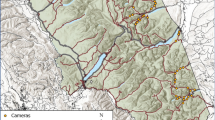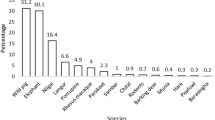Abstract
Many natural habitats exist on privately owned land outside protected areas1, but few governments can afford to enforce or subsidize conservation of this biodiversity. Even in some developed countries, conservation subsidy schemes have only achieved limited success2,3,4. Fortunately, some landowners may be willing to accept management costs in return for other benefits5, although this remains controversial when it involves the killing of charismatic species. For example, participants in British field sports, such as fox hunting and game-bird shooting, may voluntarily conserve important habitats that are required by quarry species6,7,8. Here we report results from a multidisciplinary study that addressed this issue by focusing on three sites across central England. We found that landowners participating in field sports maintained the most established woodland and planted more new woodland and hedgerows than those who did not, despite the equal availability of subsidies. Therefore, voluntary habitat management appears to be important for biodiversity conservation in Britain. Current debates on the future of field sports in Britain, and similar activities globally, may benefit from considering their utility as incentives to conserve additional habitat on private land.
This is a preview of subscription content, access via your institution
Access options
Subscribe to this journal
Receive 51 print issues and online access
$199.00 per year
only $3.90 per issue
Buy this article
- Purchase on Springer Link
- Instant access to full article PDF
Prices may be subject to local taxes which are calculated during checkout




Similar content being viewed by others
References
Langholz, J. A. & Lassoie, J. P. Perils and promise of privately owned protected areas. BioScience 51, 1079–1085 (2001)
Ovenden, G. N., Swash, A. R. H. & Smallshire, D. Agri-environment schemes and their contribution to the conservation of biodiversity in England. J. Appl. Ecol. 35, 955–960 (1998)
Krebs, J. R., Wilson, J. R., Bradbury, R. B. & Siriwardena, G. M. The second silent spring? Nature 400, 611–612 (1999)
Kleijn, D., Berendse, F., Smit, R. & Gilissen, N. Agri-environment schemes do not effectively protect biodiversity in Dutch agricultural landscapes. Nature 413, 723–725 (2001)
Goodman, P. S., James, B. & Carlisle, L. in Mainstreaming Biodiversity in Development. Case Studies from South Africa (eds Pierce, S. M., Cowling, R. M., Sandwith, T. & Mackinnon, K.) 21–32 (World Bank Environment Department, Washington DC, 2002)
Macdonald, D. W. Running with the Fox (Oxford Univ. Press, Oxford, 1987)
Macdonald, D. W. & Johnson, P. J. Farmers and the custody of the countryside: Trends in loss and conservation of non-productive habitats 1981–1998. Biol. Conserv. 94, 221–234 (2000)
Tapper, S. (ed.) A Question of Balance; Game Animals and their Role in the British Countryside (Game Conservancy Trust, Fordingbridge, UK, 1999)
Leader-Williams, N., Harrison, J. & Green, M. J. B. Designing protected areas to conserve natural resources. Sci. Prog. Oxford 74, 189–204 (1990)
Robinson, R. A. & Sutherland, W. J. Post-war changes in arable farming and biodiversity in Great Britain. J. Appl. Ecol. 39, 157–176 (2002)
UK Government Achieving a Better Quality of Life—Government Annual Report 2001 (DEFRA, London, 2001).
The Town and Country Planning (Trees) Regulations 1999 Statutory Instrument 1999 No. 1892 (Controller of HMSO, London).
The Hedgerows Regulations 1997 Statutory Instrument 1997 No. 1162 (Controller of HMSO, London).
O'Connell, M. O. & Yallop, M. Research needs in relation to the conservation of biodiversity in the UK. Biol. Conserv. 103, 115–123 (2002)
DEFRA (Department for Environment, Food and Rural Affairs) 〈http://www.defra.gov.uk/erdp/schemes/default.htm〉 (posted 10 December 2002, modified 16th April 2003).
English Nature Annual Report April 1 2001–31 March 2002 (English Nature, Peterborough, UK, 2002)
Lovelace, D., May, R. & Perkins, R. Money Makes the Countryside Go Round (WWF, Godalming, UK, 2000)
Sutherland, W. J. Restoring a sustainable countryside. Trends Ecol. Evol. 17, 148–150 (2002)
Beedell, J. D. C. & Rehman, T. Explaining farmers' conservation behaviour: Why do farmers behave the way they do? J. Environ. Mgmt 57, 165–176 (1999)
Bennett, A. F. Linkages in the Landscape: The Role of Corridors in Wildlife Conservation (IUCN, Gland, Switzerland, 1999)
Thomas, R. C., Kirby, K. J. & Reid, C. M. The conservation of a fragmented ecosystem within a cultural landscape—the case of ancient woodland in England. Biol. Conserv. 82, 243–252 (1997)
Barr, C. J. et al. Countryside Survey 1990 Main Report (Department of Environment, London, 1993)
Robertson, P. A., Woodburn, M. I. A. & Hill, D. A. The effects of woodland management on the abundance of butterflies in Dorset, England. Biol. Conserv. 45, 159–167 (1988)
Stoate, C. Multifunctional use of a natural resource on farmland: Wild pheasant (Phasianus colchicus) management and the conservation of farmland passerines. Biodivers. Conserv. 11, 561–573 (2002)
Garbutt, R. A. & Sparks, T. H. Changes in the botanical diversity of a species rich ancient hedgerow between two surveys (1971–1998). Biol. Conserv. 106, 273–278 (2002)
Glowka, L., Burhenne-Guilman, F. & Synge, H. A Guide to the Convention on Biological Diversity (IUCN, Gland, Switzerland, 1994)
Leader-Williams, N., Oldfield, T. E. E., Smith, R. J. & Walpole, M. J. Science, conservation and fox-hunting. Nature 419, 878 (2002)
Burns, L., Edwards, V., Marsh, J., Soulsby, L. & Winter, M. Report of the Committee of Inquiry into Hunting with Dogs in England and Wales (Stationery Office, London, 2000)
Baker, P. J., Harris, S. & Webbon, C. C. Effect of British hunting ban on fox numbers. Nature 419, 34 (2002)
The Hunting Bill 2002 〈http://www.publications.parliament.uk/pa/cm200203/cmbills/010/03010.i-v.html〉 (13 December 2002).
Acknowledgements
We thank farmers in the Suffolk, Warwickshire and Berkeley hunt countries for their co-operation, and M. J. Walpole and M. S. Ridout for advice. This work was supported by CHK Charities.
Author information
Authors and Affiliations
Corresponding author
Ethics declarations
Competing interests
The authors declare that they have no competing financial interests.
Rights and permissions
About this article
Cite this article
Oldfield, T., Smith, R., Harrop, S. et al. Field sports and conservation in the United Kingdom. Nature 423, 531–533 (2003). https://doi.org/10.1038/nature01678
Received:
Accepted:
Issue Date:
DOI: https://doi.org/10.1038/nature01678
This article is cited by
-
Surveillance and habitat diversity affect European brown hare (Lepus europaeus) density in protected breeding areas
European Journal of Wildlife Research (2020)
-
Abundance, biomass and energy use of native and alien breeding birds in Britain
Biological Invasions (2018)
-
Exploring the views on hunting of Spanish hunters: effect of age and public vs. anonymous opinions
European Journal of Wildlife Research (2017)
-
Improving decision-making for sustainable hunting: regulatory mechanisms of hunting pressure in red-legged partridge
Sustainability Science (2015)
-
Predator abundance in relation to small game management in southern Portugal: conservation implications
European Journal of Wildlife Research (2009)
Comments
By submitting a comment you agree to abide by our Terms and Community Guidelines. If you find something abusive or that does not comply with our terms or guidelines please flag it as inappropriate.



